The Impact of Governance Structures on Protected Area Management
Lessons-learned with a collaborative management approach at Takamanda National Park in South West Cameroon
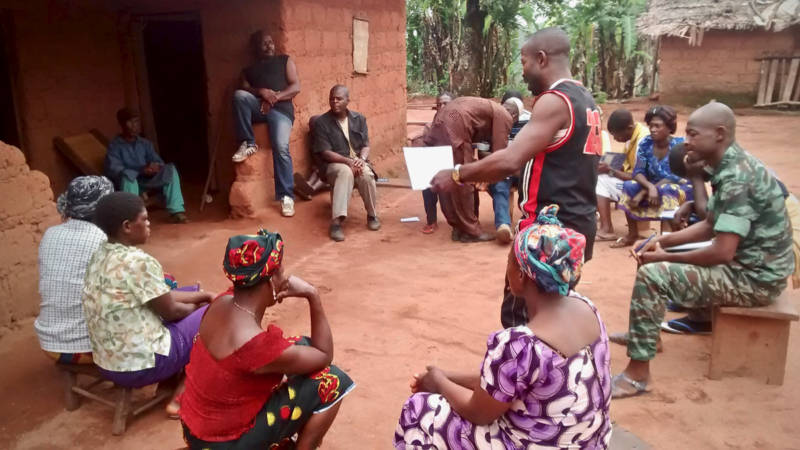
Community sensitization in Kalumo village, Takamanda National Park
The conservation of protected areas in Cameroon’s south west region has been challenging in the past years. One is community participation, even in a context where forestry and wildlife authorities are open to users’ right application. To work out a win-win scenario, the Ministry of Forestry and Wildlife’s Programme for the Sustainable Management of Natural Resources (PSMNR) with the support of other partners had adopted and implemented a collaborative management approach for the past seven years (2012-2019).
The established village development plans (VDP) are the heart of a strategy that was adopted to understand how to reconcile natural resource management and livelihoods of the forest adjacent villages. The collaborative management approach concept had been adapted to realities to realities on the ground and implemented in the later years. The implementation is marked by successes, challenges and lessons learnt.
The challenges and lessons learnt are being collated to fine tune the concept and minimize other negative stakes that may arise in the long run. The article at hand gives an insight into the concept, the approach and implementation. It goes further to present some impacts that have been observed.
Introduction
Cameroon’s Ministry of Forestry and Wildlife’s (MINFOF’s) Program for the Sustainable Management of Natural Resources (PSMNR) has been piloting an innovative protected area management approach for the past seven years around four protected areas in south west region of Cameroon. This approach is by definition not consistent or similar to participatory management currently been implemented in a handful of other protected areas in Cameroon. It is said to have some peculiarities which are captured in this paper.
The implementation of the approach makes use of several steps involving several opinion bearers taking into consideration realities in the field. The approach also relates compliance dynamics in trans-boundary governance analysis which emphasizes the fact that complex institutional underpinnings might rest on institutional design principles (Ostrom, 1990), but that as the complexity of the problem to be addressed even increases further, community involvement becomes less effective. As the size of the community grows it becomes more difficult to observe actions of others or to share information about transgressions. This generates an increased need to evolve from informal to formal modes of governance, which in turn could facilitate exchange and interaction beyond the community, friends, kinship, or family bonds. North has described this movement from personal to impersonal exchange as the essence of the process of economic development (North, 1990).
The past years have on one hand witnessed the development of guidelines and the creation of governance structures and tools so that implementation of the approach is facilitated and becomes more effective. On the other hand, it has also enabled the local communities to benefit from the approach through development efforts aimed at ‘bargaining’ the forest and ensuring a balance in interests. Development measures such as infrastructures, food security measures, social amenities are some of the achievements whose realization has gone a long way to boost conservation efforts around Takamanda National Park and the other two protected areas in South West Region. The effective implementation of the approach also depends to some extend on the efficiency of the governance structures and tools developed. This paper therefore aims to shed a light on the lessons learnt so far, their impact and where necessary consider current challenges to propose some recommendations to move forward.
Protected area management in Cameroon — legislation, approaches and experiences
In line with international conventions and agreements, the Government of Cameroon has been able to develop a national forestry policy which is reinforced by a number of legislative and regulatory acts (Lambi et al, 2012). Alongside other previous laws, the most recent Law No. 94/01 of 20 January 1994 to lay down the forestry, wildlife and fishery regulations and its implementing decrees preceded law[1] No. 96/12 of 5 August 1996 lays down the legal framework for environmental management and main guidelines and ministerial norms. The existence of these laws has not facilitated the possibility for exclusive provision of alternative means of livelihoods for protected area communities but has more or less exposed the forest adjacent communities at the mercy of conservation initiatives.
Approaches thus are developed and development measures implemented to reinforce and facilitate implementation of existing legislation while minimising natural resource base conflicts and considering national guidelines. The Cameroon forestry law pays attention to ‘participatory management’ which in the context means involving local/forest adjacent communities in forest/protected area management. The current scale on the effectiveness of local participation has been realized to have short and long-term effect/impact on sustainable management of natural resources. The population is in most cases limited to participation, not taking part in decision making nor project implementation but rather attending meetings and is always on the listening end. The current legislations involve populations through the creation of village forest management committees (VFMC) whose functionality has limited follow-up in most cases.
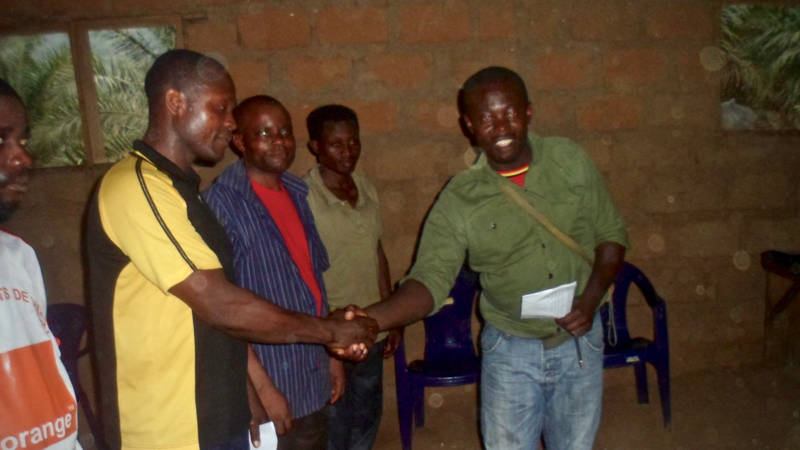
Protected area management experience in the South west region — the collaborative approach
The south west region harbours six protected areas with different management objectives based on their conservation vision and inscribed in their validated management plans. ‘Two’ different approaches are being implemented in the management of protected areas in South West Cameroon. These include the ‘participatory’ and ‘collaborative’ management approaches. Amongst these protected areas, four of them — Mount Cameroon National Park, Korup National Park, Takamanda National Park and Banyang-mbo Wildlife Sanctuary — are currently being used as pilots for the new ‘collaborative’ management approach implemented by MINFOF’s[2] PSMNR[3], technically and financially supported by German Development Bank (KFW) through GFA and GIZ. Protected area management is governed by a management plan established by a conservation organization (or consultant) and validated by MINFOF’s department of protected areas (DFAP)[4] following standard/institutionalized directives. The two approaches strive to answer the question ‘‘what is the interest of conservation to local community member/settlements?’’
Meanwhile the participatory approach encourages community members in the management of the PAs, the collaborative management approach emphasizes that community participation is not restricted to implementation but emanates from collective decision making, implementation and monitoring of activities. It involves the official/participatory distribution of responsibility and authority, although with the recognition that it is generally not possible or desirable to bestow complete management authority in the local community. The management of PAs in the South West Region is coordinated from the Regional Delegation of Forestry and Wildlife, whose function extends to formalizing the operationalization of various protected area management units amongst which is a Collaborative Management Unit (CMU). Specific terms of references are developed to direct the functioning of various units while enabling effective participation and collaboration with other stakeholders on the field where and when necessary. The CMU in collaboration with other units is responsible for ensuring the implementation and coordination of collaborative management activities around the park.
On the other hand, forest adjacent communities are not excluded but typically organized following legal provisions and supported by adapted institutions labelled ‘collaborative management’ institutions’ and including categories of individuals and groups.
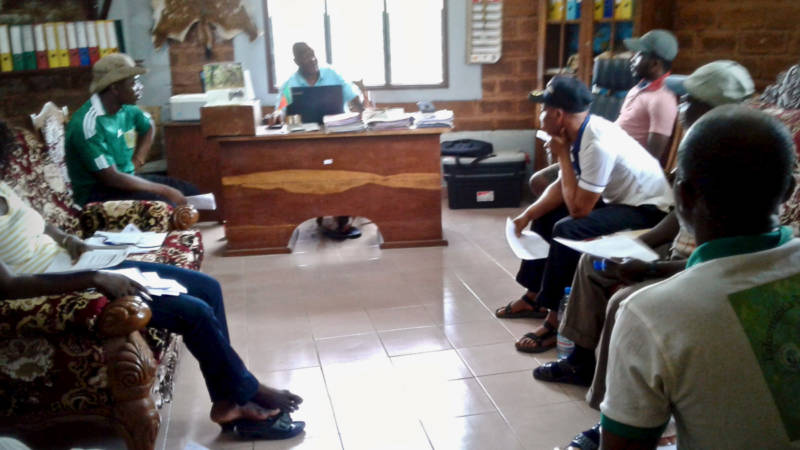
Management of the Takamanda National Park
The management of the Takamanda National Park (TNP) is overseen by the conservator’s office and assisted by other units (Collaborative Management, Trans-boundary, Research and Monitoring, Protection and Admin/Finance) headed by MINFOF personnel appointed at the regional level. Other personnel is drawn from conservation/development partner organizations for technical and financial support and includes; Wildlife Conservation Society (WCS) and GIZ represented by Technical Advisors for Protected Area and Collaborative Management respectively. On the community side, an existing legal structure known as Village Forest Management Committee (VFMC) supports the park officials, meanwhile within the framework for the implementation of the co-management[5] approach other structures have been proposed and are currently been adapted and piloted. Co-management implementation guidelines propose the creation of these other structures in order to facilitate the management approach while effectively ensuring community participation and involvement.
Based on the cultural characteristics and to some extend the geographical alignment, the conservation area (protected area) has been for management purposes divided into sub-units known as ‘cluster conservation zones’ (CCZ) to adapt management orientations to fit within specific contexts. The TNP area is carved into five cluster conservation zones: Western, South Western, Eastern, South-Eastern and Northern. These are each constituted of four or five villages which meet in a platform known as ‘‘Cluster Platform’’ (CP) to organize, plan and report contributions to park management based on orientations of the management plan and conservation development agreements (CDA). The cluster platforms and the park service designates a ‘‘Cluster Facilitator’’ (CF) whose role is to stir and animate collaboration between the villages, and also between the platform and the park service. The CF is the bridge between the community and the park service whose activities are facilitated by the park service through provision of support (operational facilitation). Community (village) participation is also facilitated via the adoption and signing of an agreement, the ‘‘Conservation Development Agreement’’ (CDA) prior to extensive consultations and negotiations. These agreements had been preceded by village to village consultations aimed at incorporating community consent in decision making processes with regards to conservation and community development efforts. This consensus has gone a long way to on one hand to disenclave communities (motor-bike roads), provide social amenities (water supplies, health unit, storage facilities, reshape local thinking, etc.) and on the other hand enhance conservation (law enforcement). In this CDA document, roles and responsibilities of both community (village) and park service are specified and project proposals elaborated subsequently based on deliberations and officialised by memoranda of understanding (MoU). These CDAs were co-signed by village authorities represented by their chiefs, park service represented by the Conservator and MINFOF by the Regional Delegate (Dupuy, 2015 & 2017).
Other tools have been developed to facilitate the implementation of the co-management approach including the CDA, Conservation incentive system[6] (conservation bonus & conservation credits), village development measures[7] (VDMs), collaborative management activities[8] (CMAs), agro-ecological surveys[9] and micro-zoning plan. These guarantee full participation of community members in the development interventions and implementation.
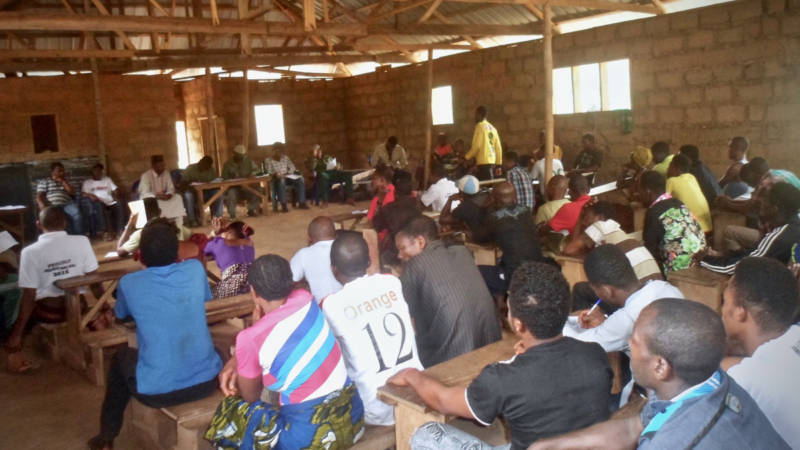
Lessons learnt from co-management governance structures
Implementation and functionality of the co-management approach
(Introduction to the structures and tools, elaboration of guidelines and tools)
Collaborative management structures include the cluster platform, the village forest management committee, and park co-management working group. The implementation of this approach has firmly given reason and made visible the role of communities in conservation from observations. The stratified intervention of community members also draws attention to the fact that consultations at various levels have led to ascertain the need to organize and capacitate communities and enabling contributions to conservation efforts. The operationalization of these structures has been guided by guidelines developed to direct their organization and role. These structural guidelines have, where necessary, been adjusted to fit the context — taking into consideration experiences from the field. This is clear with reasoning from the dynamics involved in community compliance to modalities and procedures adopted.
The VFMCs are legal structures whose creation and existence are backed by legal provisions that clearly stipulate their membership constitution and mandate. This structure in order to re-enforce the co-management approach to get a legal backing was proposed to constitute membership of the cluster platform. The platform is therefore designed to be constituted by village representatives who have membership in their respective village VFMCs. Three members per village are requested to be part of the platform amongst which is a woman. Traditional authorities represented in some cases by their chair-persons play advisory roles within the platform while trying to find a balance between conservation and development in order to benefit their communities. The approach does not lose sight of gender considerations, it ensures the integration of both gender categories taking into account their interests.
Co-management tools were developed to facilitate the functionality of the co-management approach via its structures. These have been developed such that by their design, community participation and contributions to conservation efforts are clarified with specific relation to co-management structures and taking into account local contexts. So far, the understanding of these tools has been encouraging on the community side especially as their participation in their design has led to close follow up of their use given that they are involved. The figure below summarizes the various co-management structures and tools used in the co-management approach.
Figure 1: Summary of co-management structures and tools
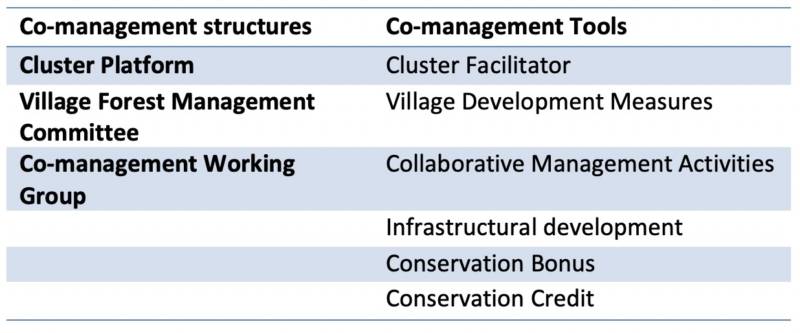
Relating co-management governance structures and co-management tools
(Cluster platforms, cluster facilitators, VFMCs, CDAs, CMAs, CDMs, etc.)
Governance structures are set up following guidelines and their functionality is enhanced by using certain tools during the implementation of the co-management approach. The co-management tools and governance structures are formulated and guided such that there exists a formal connectivity with each other. Their formulation takes into account the principle of participation and consent which are key to the co-management approach. During cluster platform meetings cluster facilitators are expected to mobilize and organize villages within the cluster, meanwhile collaborative management activities and community development measures are discussed during these meetings. The park services’ co-management unit is in charge of making sure reports and records on the activities executed during the planned period are available to enable a plenary follow-up and adoption of next steps. The cluster assembly/platform consequently enables planning of cluster activities for the semester ahead with contributions from various stakeholder’s present.
Figure: Process picture for co-management implementation
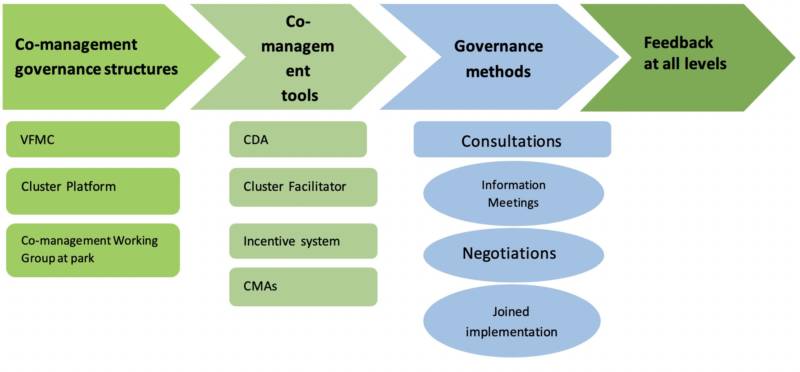
Actors and their roles in co-management implementation
(Who are they, how are they identified, etc.)
The implementation of the co-management approach in some protected areas in the south west region has mobilized the attention of various stakeholders whose interest and contributions has determined the successes recorded so far. A hand full of these stakeholders had been identified during the design of the programme whereas others were identified during implementation. They are: the Ministerial Departments of Forestry and Wildlife, Agriculture, Environment and Sustainable Development, park services, forest adjacent communities, municipal councils, non-governmental organizations, community-based organizations, department of territorial administration. The interventions and contributions of these stakeholders in the implementation of this approach have been clearly delineated, adopted and concretized through concertation, Terms or Reference (ToR) or a Memorandum of Understanding (MoU).
The figure below describes some of the identified stakeholders, contributions and the status of collaboration with MINFOF’s Programme for the Sustainable management of Natural Resources (PSMNR).
Figure 2: Summary of stakeholders and their level of implication in co-management implementation
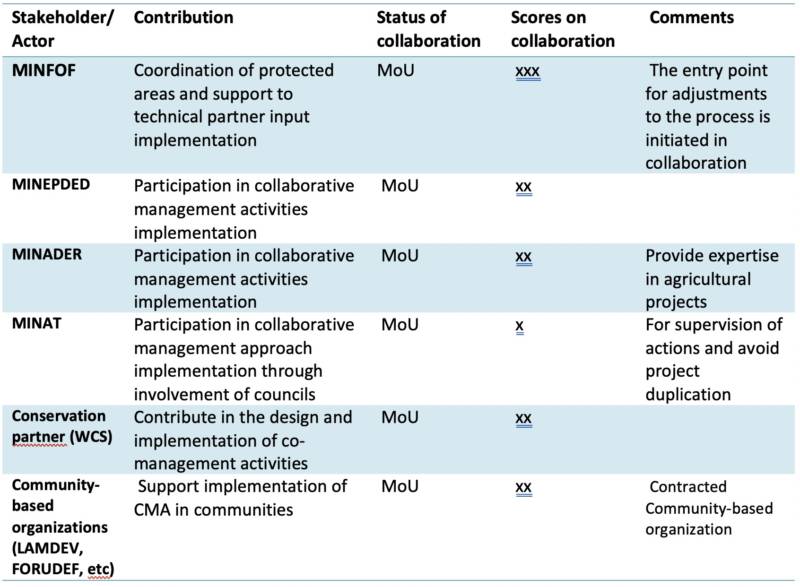
Impact of governance structures in co-management approach implementation
Efficiency of cluster platforms in co-management implementation
(Functionality, planning, reporting, monitoring and evaluation
One major impact of the collaborative management approach of protected areas is that it enables a framework mechanism for the recognition of the rights of local populations, and a process to reconcile these interests with national conservation objectives in a structured and constructive manner. This is the case especially in the context where communities give up natural resource exploitation as well as their access to protected lands for the interest of conservation. This decision has an impact on lifestyles especially where household experience a great deviation in livelihood routines.
Concerns over how the costs and benefits of protected areas are distributed among stakeholders are growing with especially the fact that these community benefits have cost implications to other stakeholders through park management. To minimize this, it is important to call for greater involvement and dialogue during activity planning and management of protected areas with other stakeholders capable of funding the parks. There is also growing recognition on the role and need for local community support to ensure that management objectives of protected areas can be achieved. Of course this can only be through ensuring the sustainability of both virtual and physical investments done by various stakeholders.
The cluster platform in the context of co-management is also considered as a monitoring tool for ensuring implementation of the planning, reporting and pre-evaluation. Activities and initiatives are proposed by the villages represented in the platform and feasibility evaluated.
Efficiency of cluster facilitators in co-management implementation
(Planning, reporting, monitoring and evaluation)
Cluster facilitators are community individuals elected or appointed to play the role of middleman between community and the national park services. As a result, he/she is a person of high moral value and capable of mobilizing community members during meetings and negotiations. These individuals are given appropriate training on how to operate and given the opportunity to concert with park authorities on sensitive issues detrimental to community participation in management and park functioning. CFs are now very conscious and play a big role in supporting various communities in planning their community efforts towards conservation as well as monitoring their interventions with respect to the respective CDAs. On the other hand, CFs support the park service through their participation in park activities that have been planned alongside communities during cluster platform meetings. They have the prerogative of making inputs in order to facilitate activity implementation at village levels. The budget allocated to CFs to cover running costs enables their movement between villages and across the clusters. In most cases they have been able to proof their utility especially in situations whereby the park service team would not be able to address issues immediately. They understand the co-management process now and are able to sensitize their communities on the approach and bring clarifications where there exist some ambiguities with respect to their role and responsibilities as well as their offtake. They are resourceful in the update of co-management design.
Adaptation of other governance structures
The implementation of co-management in and around protected areas in the south west has triggered further brainstorming on how to increasingly involve stakeholders in the restructuring and implementation of the approach. Adding to existing governance structures, co-management working groups at park level were instituted to enable an up to date platform for experience-based exchanges and discussions. This is to help make better use of experiences to shape existing guidelines and where applicable develop other tools. Other thoughts have brought to the conclusion that not everyone had been involved in the implementation of the approach from scratch. Therefore the negotiation step has seen the inclusion of the cluster negotiation adding to the village by village negotiations and signing of conservation agreements. The way forward to the implementation of this new format of negotiation will see the involvement of a broader quorum of stakeholders including the municipal councils, local civil society, development agencies, companies (in cases adjacent Forest Management Units), etc.
Conclusion
Protected area creation is a global strategy for protecting and safeguarding biodiversity. Involving communities in protected area management has been demonstrated in parts of the world to effectively and sustainably ensure sustainable forest resources. Participatory and collaborative management of forest resources and protected areas, depends very much on the socio-cultural contexts and existing regulatory framework. The implementation of co-management approach in the south west region of Cameroon is a pilot initiative aimed at bringing communities and various stakeholders on a platform of collaboration where they all contribute in decision making and activity implementation focusing on sustainability.
Footnotes
[1] Law No. 96/12 of 5 August 1996 lays down the legal framework for environmental management and main guidelines and ministerial norms (National Environment Management Programme, National Forestry Action Plan, Emergency Action Plan, Convergence Plan, National Anti-poaching Strategy, Elephant Management Plan, Forest and Environment Sector Programme)
[2] MINFOF: Ministry of Forestry and Wildlife
[3] PSMNR : Programme for the Sustainable Management of Natural Resources
[4] DFAP: Direction des Aires protégée
[5] Collaborative management is also referred to as ‘‘co-management’’ and could be defined as the sharing of power and responsibility for protected area planning and management between the government and local resource users
[6] Conservation incentive system is a system adopted to serve as compensation to communities for contribution towards conservation objectives based on participation at CP meeting, participation in CMAs, index of illegal activities, etc.
[7] Village development measures (VDMs) refers to park interventions aimed at fostering development in the village or cluster.
[8] A collaborative management activity (CMAs) refers to a set of activities whose implementation has been on a consensus between park service and communities and which could be rewarded or not
[9] Agro-ecological survey is a study which aims at making an assessment of the variations in qualitative physical and social dynamics
References
Borrini-Feyerabend, G., Farvar, M.T., Nguinguiri, J.C., Ndangang, V., 2000. Co-management of Natural Resources: Organizing Negotiation and Learning by Doing Kasparek, Heidelberg (Germany). First published 2000, Reprint 2007.
Borrini-Feyerabend, G., Pimbert, M., Farvar, M. T., Kothari, A., Renard, Y., 2004. Sharing Power. Learning by doing in co-management of natural resources throughout the world, IIED and IUCN/ CEESP/ CMWG, Cenesta, Tehran, 2004.
Dupuy, J., 2015. PSMNR-SW collaborative management approach. Program for Sustainable Management of Natural Resources, South West Region (PSMNR SWR), Buea, Cameroon.
Dupuy, J., 2017. Cluster Consultation guidelines for park management plan revision and formulation of collaborative management agreements (Cluster CDA). Programme for the Sustainable Management of Natural Resources in the South West Region (PSMNR SWR), Buea, Cameroon.North, D. C. (1990). Institutions, institutional change and economic performance. Cambridge: Cambridge University Press.
Lambi N. C., Kometa C. N., Sunjo E. T. (2012). The Management and Challenges of Protected Areas and the Sustenance of Local Livelihoods in Cameroon; Environment and Natural Resources Research; Vol. 2, No. 3. Published by the Canadian Center of Science and Education. doi:10.5539/enrr.v2n3p10
North, D. C. (2006). Understanding the process of economic change. Princeton: Princeton University Press.
Ostrom, E. (1998). A behavioral approach to the rational choice theory of collective action: Presi-dential address, American Political Science Association, 1997. American Political Science Review, 92(01), 1–22.
Ostrom, E. (1999). Coping with tragedies of the commons. Annual Review of Political Sci-ence, 2(1), 493–535.
The authors
Efuetlancha Taleih Atem, Junior Technical Advisor – GIZ, Takamanda National Park.
Valentine Buh Ebua, Senior Technical Advisor – GIZ, Team Leader, South West Antenna

